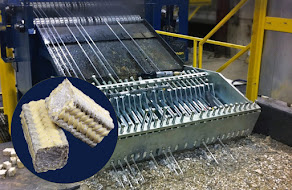Wiper blocks, also referred to as wiping pads are used in
the steel wire “continuous hot-dip” galvanization process. Steel wires are
immersed in molten zinc to render them corrosion resistant. Small amounts of
aluminium are also sometimes added. Galvanized wires are being used in a wide
range of industries and manufacturing applications.
The continuous hot-dip process requires to wipe excess
molten zinc and leave a smooth, bright coating onto ASTM Class I or III wires.
As they exit the galvanizer, each wire passes longitudinally between a set of
rectangular pads called wiper blocks. A screw mechanism compresses each set of
wiper blocks together to tightly wipe the wire before it enters the quench
tubes designed to cool off the wire.
Wiper blocks are available in a variety of sizes to suit
various wiping systems and wire diameters. They are manufactured from high
temperature resistant materials known for their abrasion resistance and
moulded
into rectangular pads, rolled into a thick block saturated with rubber or from
spun yarns braided around a core filler and impregnated with high temperature
lubricants. Some blocks are pre-moulded with a groove so larger caliber wires
can benefit from an even wiping pressure all around.
Quality and pricing vary greatly on the market, but so does
the production efficiency. Wiper blocks represent a small part of the overall
production costs, but sturdy wiper blocks, engineered with well-established
know-how, will result in increased wire quality, better finish and longer
production runs before requiring to rotate or replace the blocks.



Comments
Post a Comment